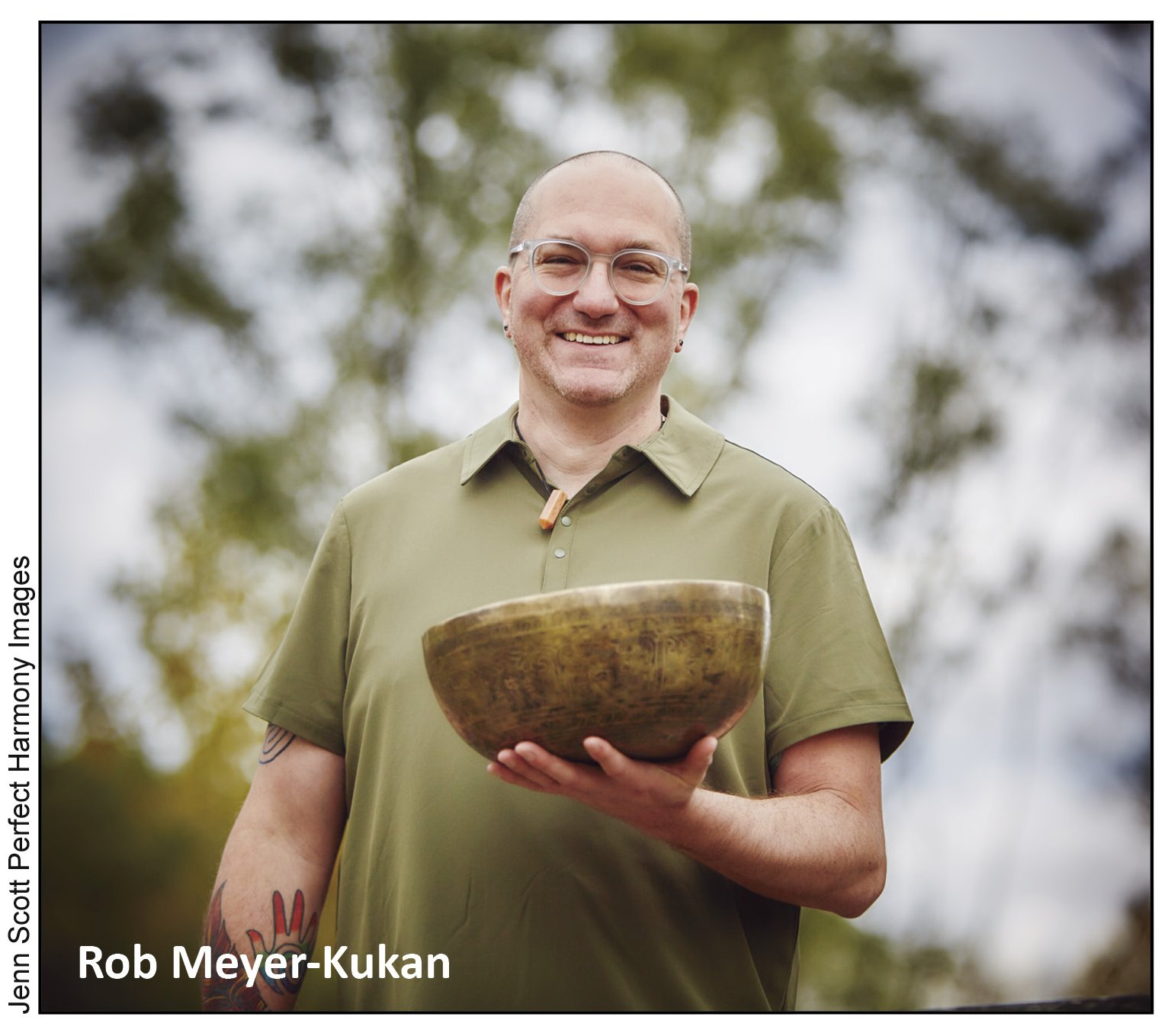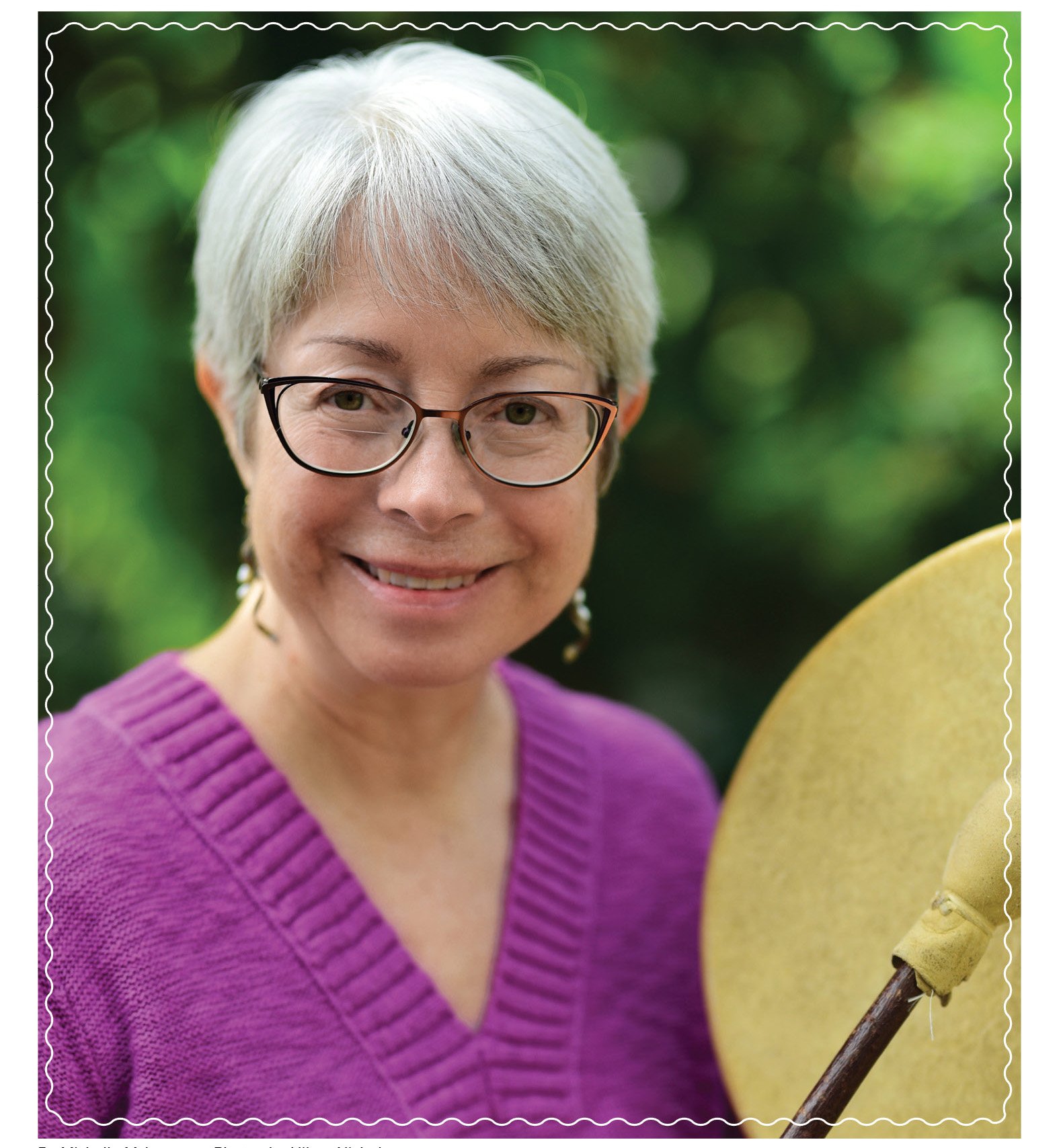By Catherine Carr
I am lying on the floor of a friend’s apartment as she sets up her singing bowls. The bowls—made variously of metal and crystal, ranging in size from soup bowls to witches’ cauldrons—emit specific frequencies of sound when vibrated. I close my eyes. Daniella begins to play. In my mind’s eye, I see the sounds as colors—slow circles of ink spreading out around and through me from where each bowl plays. I am immersed in sound and color.
There is nothing quite like the sound that’s produced by singing bowls. There is a warmth and depth to it that an electronic speaker cannot replicate; the speaker lacks the physical properties which allow the bowls to vibrate just so. It swells smoothly from the faintest whisper into a sound that is itself almost an object, an energy field that vibrates through your body like a cellular massage.
The use of brass bells to produce deep, resonating notes of sound appears to date back 3,500 years in the Himalayas. Anyone who has heard a Chinese brass bell or gong rung knows that these sounds have a similar quality: slow and deep, growing, then fading so gradually as to overwhelm the mind and focus its attention. For this reason, they are often used in meditation services and rituals. The sound overwhelms the senses at its peak, then fades gradually to draw attention toward silence.
The use of singing bowls—bowls which produce sounds of similar quality by being rubbed rather than struck, allowing the sound to be sustained and its volume finely controlled—appears more recent. Records dating back millennia reference the use of gongs and bells in ritual and healing, but the bowls seem to have appeared sometime in the 20th century.
The people of the Himalayas are not the only ancient pioneers to believe that sound could have divine healing properties. The belief that certain frequencies of sound had creative properties is found in Sanskrit thought, where it is related to the use of mantras to promote certain types of spiritual and physical healing and development. The Greek philosopher, Pythagoras (yes, of Pythagorean theorem fame), coined the term “music of the spheres” to describe sounds that he believed were produced by the heavenly spheres which were thought to carry planets in orbit around the Earth. He believed that this music could influence the human soul.
Today, we know that this is not entirely without truth: different frequencies, harmonies, and rhythms of sound can affect our brain activity. While the planets don’t emit any music that we can hear, use of sound by skilled musicians can produce desired emotional and mental states which may even have an impact on our physical health.
“Sound therapy” can refer to many practices including the use of singing bowls and ancient, traditional instruments, the use of recorded nature sounds and the use of specially formulated music therapy. All of these modalities do appear to produce benefits to mood, mental function, and sense of well-being. But how much truth is there to claims that sound therapy works because sounds affect the shape of water or because the human body has an “ideal healthy frequency?”
For this article, I set out to find out. I went for assistance to Rob Meyer-Kukan, a church musician-turned-sound therapist who now runs 7 Notes Natural Health in the Ann Arbor area.
Meyer-Kukan had always known he loved the sounds produced by bells, perhaps not unlike those produced by the first bells and gongs of ancient China. When an injury limited his ability to continue working as a church musician, his friends recommended that he explore sound therapy with Himalayan singing bowls.
“At first I said, ‘that’s a bunch of hooey,’” Meyer-Kukan tells me in our interview. But his curiosity got the better of him, and he signed up for singing bowl training. “The first time I held a Himalayan singing bowl, I knew there was something here. And I needed to share it with people.”
Like so many sound therapists and other alternative therapists, Meyer-Kukan found himself caught in a tug-of-war between unscientific claims made by questionable “experts,” and scientifically validated findings showing that his art could improve well-being and be useful as part of a healing regimen. While some prominent “experts” made claims the scientific community rejected due to poor methodology, clinical trials turned up real benefits from sound therapy.
“We try not to say that we ‘treat’ anything,” Meyer-Kukan tells me. “Sound therapy is not a substitute for traditional medicine. But it can be very restorative. The best thing a patient can say to me is ‘I feel like I just took a thousand naps.’”
Meyer-Kukan’s caution in making healing claims is understandable. Some subscribers to the philosophy of sound therapy have been known to claim to “cure” serious illnesses. While it is possible that sound therapy may strengthen patients’ immune and healing responses in some cases, there’s no evidence to suggest it’s a good idea to rely on sound therapy alone to treat anything.
Dr. Masaru Emoto has become famous in some metaphysical circles for claiming to have proven that certain wavelengths of light and sound, as well as certain thoughts and emotions, can change the nature of water and cause it to form different crystal structures. His belief in an inherent link between the effects of physical vibrations on water and the emotions and thoughts of people have been cited by some in the sound therapy community to explain the success of their techniques.
Unfortunately, Emoto’s research has not met the standards the medical and scientific communities generally require of their members. He has not reported the details of the methods he has used to obtain his results, meaning that his samples may have been influenced by variables outside those he is studying. Emoto has so far declined to reproduce his results under the rigorously controlled experimental conditions used by peer-reviewed medical researchers, despite being offered a $1 million prize to prove his claims up to the standards generally accepted by the medical community by James Randi, founder of the One Million Dollar Paranormal Challenge.
Emoto’s research has also inspired engineers to prove that sound vibrations do affect the activity of water molecules. While it has been proven that sound vibrations have physical effects on water molecules, these have not been proven to have health benefits, and are unlikely to be the source of benefit from sound therapy. As we will see, there are more well-established and proven mechanisms by which binaural and relaxing sounds may affect mood, and even the body’s immune and healing functions.
What sound can definitely do is change brain activity. And this is more important than many people may realize. Changed brain activity may have profound effects on the body. This is the basis for Meyer-Kukan’s favorite techniques to use at Seven Notes.
“When looking for a sound therapist,” Meyer-Kukan advises me, “ask someone about their instruments. Different instruments do different things. Singing bowls are my favorite, personally. They have a very gentle and relaxing quality. Other instruments have a more thrilling, exciting effect. What you do in sound therapy will depend on the goal you want to achieve.”
“Also look for someone who has knowledge of binaural beats,” Meyer-Kukan continues. “The idea is that two different frequencies can work together to produce specific patterns of activity in the brain.” According to this theory, patterns of brain activity produced can range from the types of slow, restorative Delta waves found in deep sleep to the fast, high-frequency Gamma brain activity associated with bolts of insight and states of inspiration.
Scientific studies have been inconclusive in their findings as to whether sound therapy techniques reliably produce the brainwave patterns to which their effects on mood and well-being are attributed. But studies have found consistent benefits to patient well-being from several types of sound therapy, including singing bowl therapy, the use of healing mantras, and the use of recorded relaxing sounds, such as nature sounds. People with anxiety have consistently reported improvement in anxious thoughts and feelings after sound therapy. One study published in the Journal of Evidence-Based Complementary & Alternative Medicine found that 62 participants felt significant improvements in their senses of spiritual well-being, with decreases in anger, depressed mood, fatigue, and tension after a Tibetan singing bowl session.
The tension-relieving effects appeared strongest for those who had not experienced Tibetan singing bowl meditation before. The authors proposed that singing bowls could be an effective low-cost intervention to relieve tension, anxiety, and depression, and improve spiritual well-being.
A study of 47 breast cancer patients published in the journal of Psycho-Oncology in 2013 tested the effects of a Tibetan Sound Meditation program featuring healing mantras and audio CDs of traditional Himalayan healing sounds. The study found that patients suffering from “brain fog” associated with their illness and the effects of chemotherapy experienced improvements in self-reported mental health, and spirituality while participating in the sound meditation program.
Some patients also scored higher on tests of learning and memory, cognitive processing speed, and cognitive abilities after treatment. Study authors cautioned that these improvements had disappeared one month after the Sound Meditation program ended, but that the program did appear to improve patients’ quality of life during the study.
A clinical trial published in the International Journal of Nursing Studies in 2014 sought to determine whether the use of sounds from nature could improve clinical outcomes in 120 heart surgery patients undergoing the stressful process of being weaned off ventilators. In this patient group, stress could actually prove deadly: the elevated blood pressure and heart rates caused by anxiety could cause potentially life-threatening complications for hearts and coronary arteries recovering from surgery.
Read related article: Me, My Guitar, and I
The study found that the use of headphones playing nature-based sounds significantly reduced levels of anxiety and agitation in these patients. Significant differences were also found in blood flow as a result, potentially reducing the likelihood of complications in the nature sound treatment group.
The study authors recommended that critical care nurses could use such recorded sounds to improve patients’ experience of stressful procedures, and that more studies should be conducted to determine if this technique could be used to reduce risk of complications across different patient demographic groups.
Even more intriguing, at least one study has found decreases in stress hormone levels following sound therapy with several types of traditional and meditation music. This finding is not at all surprising, since anything which produces a relaxed and restorative mental state has been found to lower levels of stress hormones. However, confirming this finding is important because stress hormones play a big role in medical outcomes.
Well-intended hormones, such as cortisol, are made to help us fight acute threats. To do this, they raise our blood pressure and blood sugar while suppressing our immune systems and healing functions. This is great for an actual fight-or-flight situation when our cells need the extra oxygen and sugar supplied by our blood to fight for our lives. But when the source of our stress is a work email or a medical procedure, obviously suppressing our immune and healing functions is not so great.
The effect of relaxation and improved sense of well-being on stress hormones is thought to be one cause of the occasional “miraculous” recoveries reported by those who undergo holistic medicine retreats and find that their medical situations soon begin to improve.
While relaxation alone has not been proven to rival modern medicine in curing any disease or injury, adding relaxation therapies to modern medical treatment has been shown to improve outcomes in many conditions. This may occur through the pathway of decreasing stress hormone levels allowing for increased immune system and healing activity.
A study undertaken by medical staff and music students at the University of Tokyo measured stress hormone levels in ten participants before and after a music therapy session. The scientists tested several different types of music, including music with traditional Japanese instruments, Gregorian chant, music utilizing traditional African rhythms, and music using harmonics which were designed to invoke images of natural beauty.
Researchers found that levels of the stress hormones norepinephrine and corticotropin, and cortisol in participants’ blood had decreased significantly after the music therapy sessions. Though no specific differences were reported between the different types of music, these results suggest that further study of the effects of different types of music and sound therapy on stress hormones is warranted.
Still, relaxing sounds can’t fix everything. A different clinical trial published in the European Journal of Cardiovascular Nursing in 2009 found that the use of recorded relaxation sounds supplied by a company called MusiCure made patients and healthcare staff alike feel more relaxed during coronary angiography procedures but did not improve the medical outcomes of the procedures.
So, what exactly can sound therapy do? It can feel restorative. It can produce feelings of relaxation and enhanced well-being. These benefits may in turn lower levels of stress hormones and free our bodies’ natural healing mechanisms to do their work.
These results mesh well with Meyer-Kukan’s philosophy of sound therapy.
“I don’t do the healing,” he told me in our interview. “I do therapeutic work to help the body heal itself.” This is a startling literal description of what happens when stress hormones are downregulated: the body’s own immune and healing functions receive the message that they are liberated from immediate danger. They are then free to do their work.
Sound healing is an excellent case study for the interplay of instinct and medical science which pervades the study of wellness. While our instincts can sometimes lead to incorrect conclusions—sound therapy probably cannot cure any illness through its effect on water molecules, for example—what feels right to us often does prove helpful, even if medical science doesn’t immediately know how to explain these benefits.
When we combine our instincts about how to optimize our well-being with the medical advice supported by the best experimental evidence, then we get the best results.
The first time Rob Meyer-Kukan held a singing bowl in his hands, he knew that something important was happening. His experience mirrors those of so many other sound therapy patients and practitioners: they may not be able to explain how the sounds they are experiencing can have therapeutic properties, but they know that they do. As medical science marches on, it tells us more about the brain-body relationship, and how these therapies that we instinctively know benefit us can be used to the benefit of modern medicine.
Rob Meyer-Kukan can be reached through his sound therapy practice, 7 Notes Natural Health. Find him online at 7notesnaturalhealth.com or contact him by email at contact@7notesnaturalhealth.com or by phone at 248-962-5475. The 7 Notes Natural Health office is located at 3830 Packard Street Suite 120 in Ann Arbor, MI.
Catherine Carr is a former clinical research coordinator, current freelance writer, and community minister in training with Cherry Hill Seminary. She obtained her bachelor’s degree in Neuroscience from the University of Michigan in 2011. She can be reached at clkagmi@gmail.com.


































































































































































































Living on a farm in Chelsea, Ramsey’s journey from community developer and social worker to shamanic practitioner and animal chaplain exemplifies an authentic evolution of one’s unfolding of identity, own healing, and epiphany in recognizing one’s place within the actual world contrary to the confines and misperceptions of society.